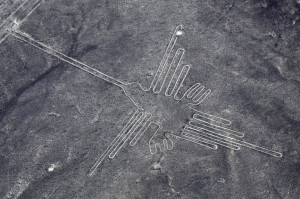
The number of known ancient drawings in Peru by the mysterious Nazca culture has grown considerably. Scientists from the University of Yamagata in Japan discovered geoglyphs that are at least 200 years older than the Nazca plateau images previously cataloged at the UNESCO World Heritage site. The research group used 3-D scans to uncover what appear to be representations of native llamas. The current UNESCO listing contains a monkey, a spider and a hummingbird. The drawings are located approximately one mile to the north of Nazca, on a slope. They are nearly invisible from the ground, but grow more distinct from higher elevations.
Hillside Location
The research team has discovered a total of 41 drawings over the course of a year. They are distinguished, in part, by their position on a hillside. Masato Sakai believes the location was chosen to make them as visible as possible. Size is another notable feature. The drawings are between 16 and 66 feet tall. The Japanese team puts their age at around 400 B.C. to 200 B.C. The hummingbird and other drawings are said to date from 400 A.D. to 650 A.D. The researchers believe that the newly discovered images were created using a different method than the younger drawings.
Different Technique
The Nazca Pampa in Peru sits between the Andes mountain range and the Pacific coast. It is a dry region, with a surface of black pebbles over white ground. Sakai says that the method of creating the already-famous drawings involved removing the black stones to create outlines for the animals. The llamas were created by removing stones in the shape of the whole body of the animal, so that the entire figure is white, not merely the contours.
Nazca Images a Pilgrimage Map
The Nazca culture holds many mysteries for researchers and lay people alike. Nazca society was virtually extinct before the Incans became the predominant culture in this mountain region. The Nazca history spans approximately 600 years, from 100 B.C. to between 400 and 500 A.D. One of the great mysteries lies in the geometric lines and patterns the Nazca drew, which are visible most clearly from the air. Archaeologists and anthropologists have long wondered about the apparent Nazca interest in appealing to an aerial view.
An Enigmatic Civilization
The ancient Nazca people shared some traits with subsequent cultures, while remaining unique in other ways. Pottery attributed to the Nazca depicts images such as the San Pedro cactus, known for producing a hallucinogenic substance. It is believed that shamans would have used hallucinogens to induce visions and communicate with the gods during feasting times. Cahuachi was the place where celebrants would gather to worship, in the hope of optimizing the harvest and promoting fertility. High-ranking members came together with the common folk to feast for an extended period. The elite used this time to curry political favor and to secure a labor force for construction by bestowing gifts of pottery and other valuables. The Nazca worshiped a mythical anthropomorphic figure, as well as other mythological creatures, such as:
- The spotted cat
- The killer whale
- The serpent
Another distinguishing feature of the ancient Nazca was the society’s interest in trophy heads. The Nazca reportedly held the largest store of human heads among societies in the region.
Area Endangered by Growth
The researchers responsible for the latest discovery of the drawings are concerned that urban expansion will destroy the drawings. Sakai wants local government to recognize the images as geoglyphs, and move to protect them. Sakai and his team say this area contains the largest concentration of geoglyphs in the area, but the images are faint. He is concerned that the drawings will be undervalued as cultural artifacts, and that modern interests will make them extinct, along with the society that created them.

